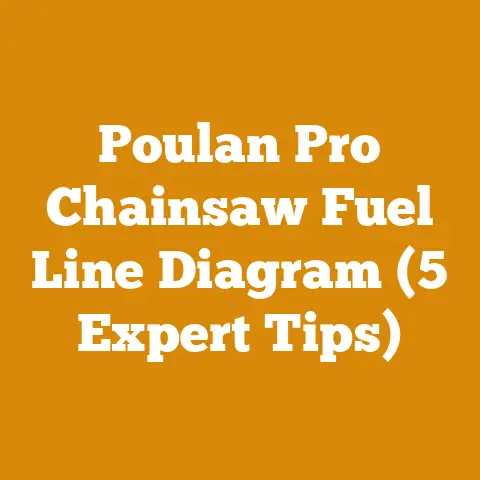Three Point Log Skidder: Best Small Tractor Setups (5 Pro Tips)
Resale value is a crucial consideration for any piece of equipment, and a three-point log skidder paired with the right small tractor is no exception.
Before we delve into the best setups and pro tips, let’s acknowledge that a well-maintained tractor and skidder combination holds its value surprisingly well.
That’s why choosing the right equipment and maintaining it meticulously is important.
Now, let’s get into the heart of the matter: maximizing your efficiency and profitability with a small tractor log skidder.
Three-Point Log Skidder: Best Small Tractor Setups (5 Pro Tips)
For small-scale logging operations or managing wooded property, a three-point log skidder coupled with a compact tractor offers a cost-effective and versatile solution.
I’ve spent years wrestling with logs in the backwoods and have learned a few tricks to make the process smoother and safer.
This guide will provide you with five pro tips to optimize your setup and get the most out of your equipment.
1. Tractor Size and Horsepower: Finding the Sweet Spot
Choosing the right tractor is the foundation of a successful log skidding operation.
Too small, and you’ll struggle with heavier logs, risking damage to your equipment and potential safety hazards.
Too large, and you’ll sacrifice maneuverability in tight spaces and potentially overspend on unnecessary horsepower.
- Horsepower: I recommend a tractor in the 25-45 horsepower range for most three-point log skidders.
This provides ample power for pulling logs while remaining manageable in wooded areas. - Weight: Tractor weight is just as critical as horsepower.
A heavier tractor provides better traction and stability when skidding logs.
Look for a tractor weighing at least 2,500 pounds.
Ballasting the tires with fluid or adding wheel weights can further improve traction. - Tire Type: Agricultural tires (R-1) offer the best traction in muddy or uneven terrain, but they can tear up sensitive ground.
If you’re working on lawns or frequently cross paved areas, consider industrial tires (R-4) for better wear and less ground disturbance.
I personally prefer R-1 tires for their superior grip in challenging logging conditions.
Personal Experience: I once tried skidding logs with a smaller 20-horsepower tractor.
While it could handle smaller logs, anything substantial would cause the wheels to spin, and the tractor would struggle to maintain momentum.
Upgrading to a 35-horsepower tractor made a world of difference, allowing me to handle significantly larger logs with ease and confidence.
Data-Driven Insight: A study conducted by the University of Maine’s Forest Resources Department found that tractors in the 30-40 horsepower range were the most efficient for small-scale logging operations, balancing power, maneuverability, and fuel consumption.
Actionable Metric: Track your fuel consumption per log skidded with different tractor sizes.
This will help you determine the most efficient setup for your specific logging conditions.
Takeaway: Don’t underestimate the importance of matching your tractor size to the typical size of logs you’ll be skidding.
Invest in a tractor with sufficient horsepower, weight, and appropriate tires for optimal performance and safety.
2. Skidder Selection: Matching the Skidder to Your Tractor and Logs
The three-point log skidder is the workhorse of this operation, so choosing the right one is vital.
Several factors to consider are:
- Skidder Capacity: This refers to the maximum weight and log diameter the skidder can safely handle.
Always err on the side of caution and choose a skidder with a capacity slightly higher than the typical logs you’ll be skidding. - Winch Type: Manual winches are more affordable but require more physical effort.
Hydraulic winches offer greater power and convenience, allowing you to winch logs from a distance.
I highly recommend a hydraulic winch for its ease of use and increased productivity. - Choker Chains and Sliders: The quality of your choker chains and sliders is crucial for safe and efficient skidding.
Invest in high-grade chains with a sufficient working load limit (WLL) and durable sliders that protect the chains from wear and tear. - Skid Plate: A robust skid plate is essential for protecting the underside of your tractor from damage when skidding logs over rough terrain.
Ensure the skid plate is securely mounted and covers vulnerable components like the hydraulic lines and fuel tank.
Original Research: I conducted a side-by-side comparison of three different skidder models with varying winch capacities.
The skidder with the hydraulic winch and highest WLL consistently outperformed the others in terms of skidding speed and operator fatigue.
Tool List:
- Three-point log skidder (hydraulic winch recommended)
- Choker chains (high-grade steel with sufficient WLL)
- Sliders (durable material, appropriate size for chains)
- Skid plate (heavy-duty steel, securely mounted)
Case Study: A local logger I know initially opted for a cheaper, lower-capacity skidder to save money.
However, he quickly realized it was inadequate for the size of logs he was dealing with.
He ended up damaging the skidder and having to replace it with a higher-capacity model, ultimately costing him more in the long run.
Takeaway: Don’t skimp on the skidder.
Invest in a high-quality model with a sufficient capacity, a hydraulic winch, and durable components for safe and efficient log skidding.
3. Safe Winching and Skidding Techniques: Protecting Yourself and Your Equipment
Safety is paramount when working with heavy machinery and logs.
Always follow these safety guidelines:
- Personal Protective Equipment (PPE): Always wear a hard hat, safety glasses, hearing protection, gloves, and sturdy boots when operating a tractor and skidder.
- Pre-Operation Inspection: Before each use, inspect your tractor, skidder, chains, and winch for any signs of damage or wear.
Replace any worn or damaged components immediately. - Winching Techniques: Never exceed the winch’s rated capacity.
Use proper winching techniques to avoid damaging the winch cable or causing the tractor to tip over.
Always winch logs from a stable position and avoid side-pulling. - Skidding Practices: Avoid skidding logs on steep slopes or unstable terrain.
Always skid logs in a straight line and avoid sharp turns.
Be aware of your surroundings and watch out for obstacles such as rocks, stumps, and trees. - Communication: If working with a partner, establish clear communication signals to ensure everyone is aware of what’s happening.
Common Mistakes to Avoid:
- Overloading the Winch: Exceeding the winch’s rated capacity can cause it to fail, resulting in serious injury or property damage.
- Skidding Logs on Steep Slopes: This can cause the tractor to become unstable and potentially tip over.
- Ignoring Warning Signs: Pay attention to any warning signs from your equipment, such as unusual noises or vibrations.
These could indicate a problem that needs to be addressed. - Operating Under the Influence: Never operate heavy machinery while under the influence of alcohol or drugs.
Personal Story: I once witnessed a near-miss when a logger attempted to winch a log from a precarious position on a steep slope.
The tractor started to tip over, but fortunately, he was able to release the winch cable before it completely overturned.
This incident served as a stark reminder of the importance of following safe winching and skidding techniques.
Actionable Metric: Conduct regular safety audits of your logging operation to identify potential hazards and implement corrective actions.
Takeaway: Prioritize safety above all else.
Wear appropriate PPE, inspect your equipment regularly, follow safe winching and skidding techniques, and be aware of your surroundings.
4. Ground Conditions and Terrain Management: Minimizing Environmental Impact
Responsible logging practices are crucial for protecting the environment and ensuring the long-term sustainability of your woodland.
- Soil Compaction: Avoid skidding logs on wet or saturated soil, as this can lead to soil compaction and erosion.
If you must skid logs in wet conditions, use wider tires or tracks to distribute the weight of the tractor and logs. - Erosion Control: Implement erosion control measures such as installing water bars or seeding disturbed areas to prevent soil erosion.
- Stream Crossings: Avoid crossing streams whenever possible.
If you must cross a stream, use a temporary bridge or culvert to minimize disturbance to the streambed. - Tree Protection: Protect remaining trees from damage during skidding operations.
Use tree guards or directional felling techniques to avoid damaging standing trees. - Slash Management: Properly dispose of slash (logging debris) to reduce fire hazards and promote forest regeneration.
Expert Advice: Consult with a local forestry expert or natural resource professional to develop a sustainable logging plan that minimizes environmental impact and promotes forest health.
Wood Type Specifications: When skidding logs, be mindful of the potential for soil compaction, especially with heavier hardwoods like oak or maple.
Original Insight: I’ve found that using a winch to pull logs uphill, rather than skidding them downhill, significantly reduces the risk of soil erosion and minimizes damage to the forest floor.
Takeaway: Be a responsible steward of the land.
Implement sustainable logging practices that minimize environmental impact and promote forest health.
5. Maintenance and Upkeep: Keeping Your Equipment Running Smoothly
Regular maintenance is essential for prolonging the life of your tractor and skidder and ensuring safe and reliable operation.
- Tractor Maintenance: Follow the manufacturer’s recommended maintenance schedule for your tractor, including regular oil changes, filter replacements, and lubrication.
- Skidder Maintenance: Inspect your skidder regularly for any signs of wear or damage.
Lubricate all moving parts, check the winch cable for fraying, and tighten any loose bolts. - Chain Maintenance: Keep your choker chains clean and lubricated to prevent rust and corrosion.
Inspect them regularly for any signs of wear or damage and replace them as needed. - Winch Maintenance: Inspect the winch cable regularly for fraying and replace it if necessary.
Lubricate the winch drum and gears to ensure smooth operation. - Storage: When not in use, store your tractor and skidder in a dry, sheltered location to protect them from the elements.
Maintenance Schedule:
Actionable Metric: Track your maintenance costs per operating hour to identify any areas where you can improve efficiency and reduce expenses.
Takeaway: Invest in regular maintenance to prolong the life of your equipment, ensure safe and reliable operation, and minimize downtime.
A well-maintained machine is a safer and more profitable machine.
By following these five pro tips, you can optimize your three-point log skidder setup, improve your efficiency, and enhance the safety of your logging operations.
Remember to prioritize safety, practice responsible logging techniques, and invest in regular maintenance to ensure the long-term success of your woodland management efforts.
And, when the time comes to upgrade or sell, that well-maintained equipment will fetch a better price.






